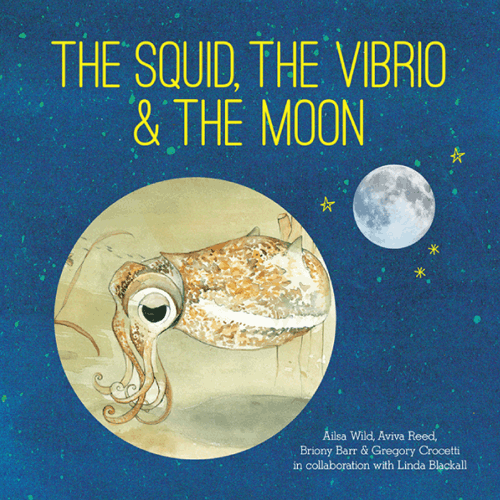Book review
Microbiology Australia 40(1) 52-52 https://doi.org/10.1071/MA19014
Published: 21 February 2019
The Squid, The Vibrio & The Moon
Ailsa Wild, Aviva Reed, Briony Barr, Gregory Crocetti and Linda Blackall
CSIRO Publishing, 2019

|
A Hawaiian bobtail squid, Vibrio fischeri, and the moon: three seemingly unrelated characters with a mysterious evolved relationship that is revealed in this engaging, delightful and colourful children’s story. It’s a dramatic tale of squid development and the uptake of symbiotic Vibrio cells, which provide bioluminescent camouflage against the moon as the squid hunts at night, protecting the squid from dangerous predators such as lizardfish and monk seals. The story is beautifully illustrated with ink and water colours, showing microbes and chemical reactions labelled unobtrusively with scientific terms and taxonomic names in non-intimidating, handwritten script. The text tells a compelling story for a young audience but leaves many aspects of the drawings unexplained, giving opportunity for a teacher or a knowledgeable parent to embellish on the biology and answer questions about what is depicted. It anthropomorphises the characters – such as bacteria running for their lives from threatening protozoa, and the Great Guardian Haemocytes with their monocular eye (a nucleus, of course), but this is harmless fun and should hold a young listener’s attention. The characters have scientifically meaningful names, such as Ali, Spiri and Sepio, which can also lead to further discussion.
The 28-page story is aimed at a primary school audience, and it is followed by a 13-page section on the underlying science that could be appreciated by advanced primary school or junior secondary school students. Topics such as symbiosis, squid biology, quorum sensing, genetics, classification and the chemistry of bioluminescence as well as a glossary are explained lightly and concisely, with ample illustrations in the same colourful, story book vein. Similar to the authors’ other delightful book (Zobi and the Zoox; A Story of Coral Bleaching), the story emphasises mutualistic symbiosis, not just its importance in evolution and ecology but also as a lesson for children about cooperation. The book is a beautiful, engaging, and effective work of science communication for a young audience.
Also valuable are the publisher’s online notes for teachers. The notes include learning objectives, quizzes for kids, thought-provoking questions for discussion, drawing activities, related learning activities, and links to relevant curriculum resources.
Associate Professor Jeff Shimeta
School of Science
RMIT University
Melbourne, Australia


